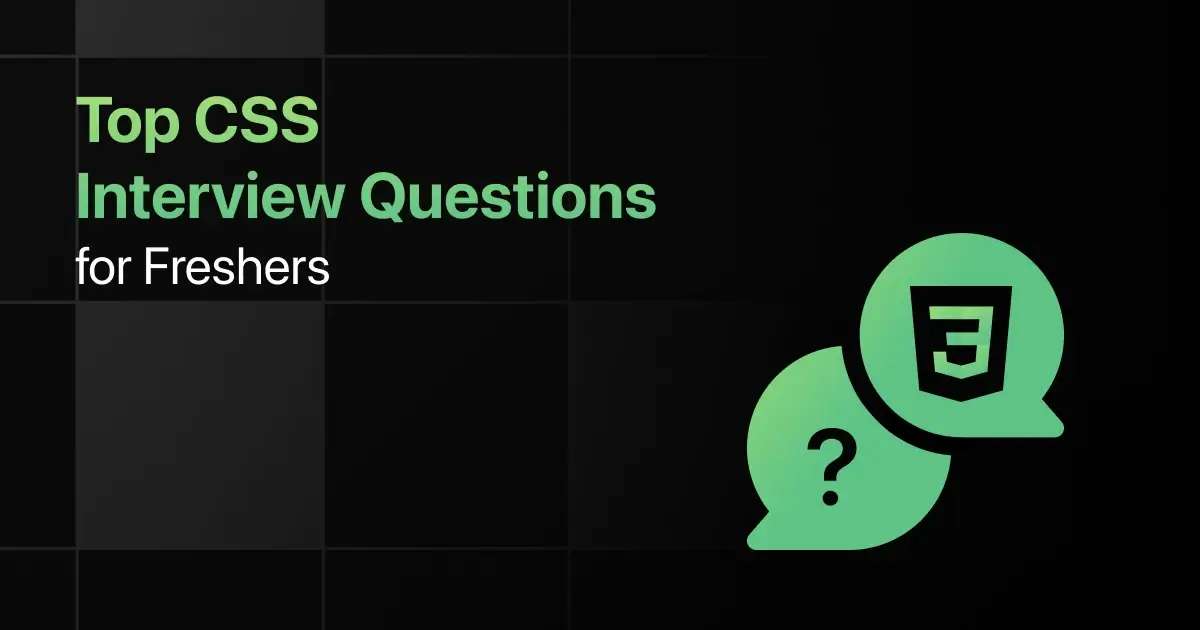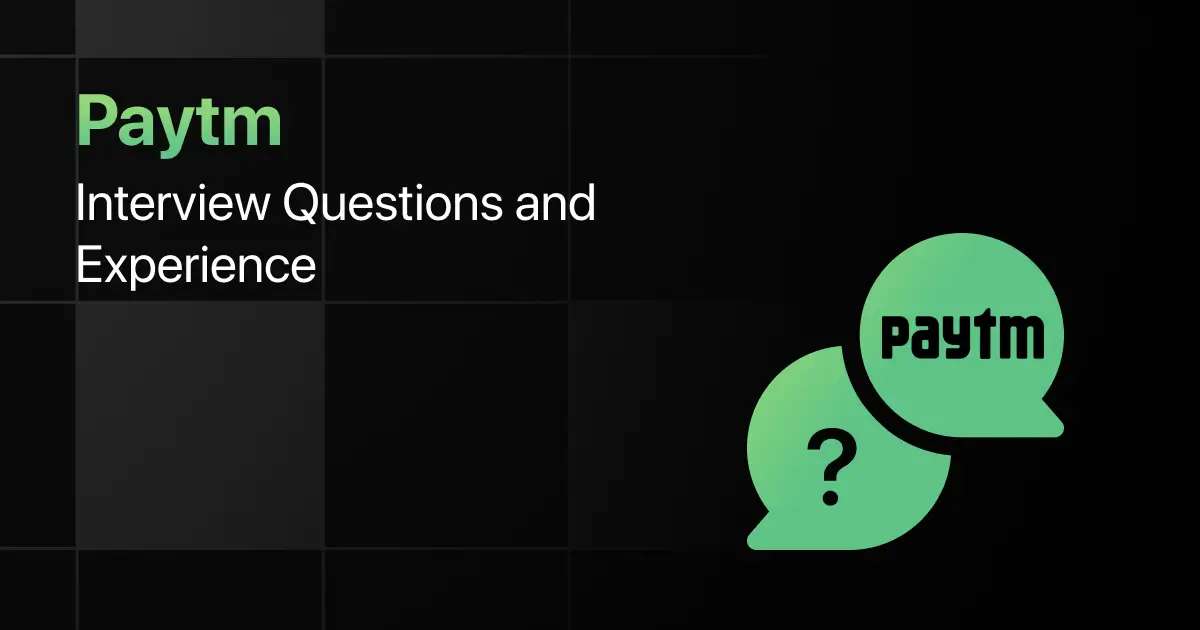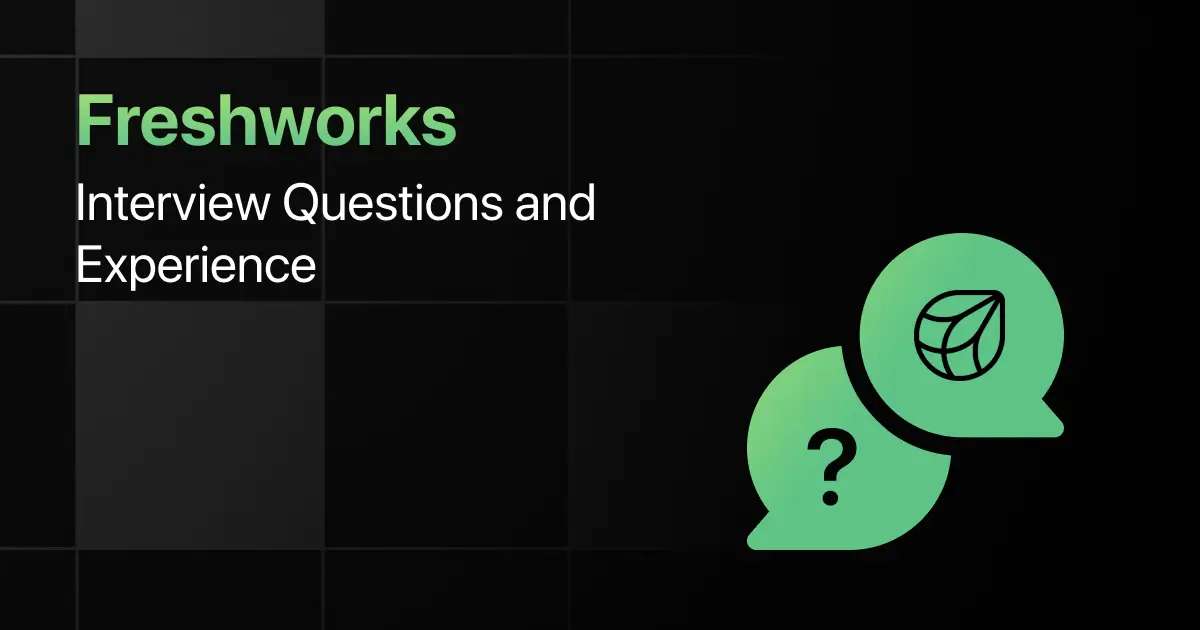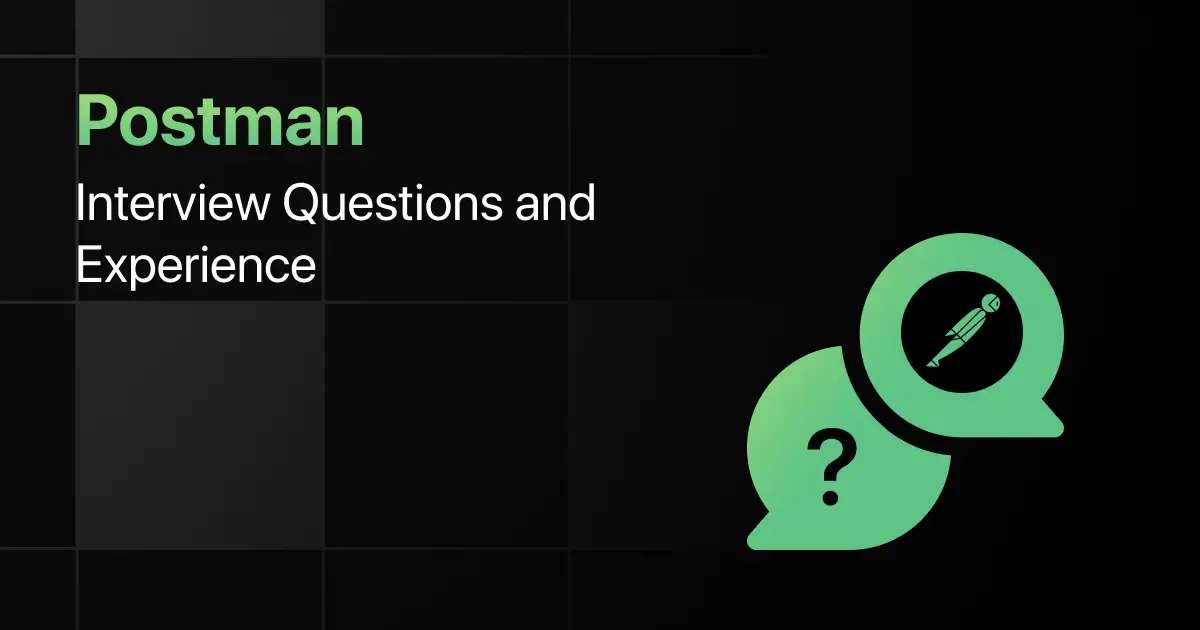Top CSS Interview Questions for Freshers

Are you preparing for your first CSS interview and wondering what questions you might face? Understanding the key CSS interview questions for freshers can give you more clarity.
This blog is here to help you get ready with practical questions that test your real-world problem-solving skills. We’ve gathered some of the most common basic CSS interview questions that freshers often encounter.
With this guide, you’ll be well-prepared to tackle these CSS interview questions and answers for freshers and make a strong impression in your interview.
Practice CSS Interview Questions and Answers
Below are the top 50 CSS interview questions for freshers with answers:
1. Write CSS code to select and style all paragraph elements that are direct children of a div.
Answer:
Use the child combinator (>) to target direct children.
div > p {
color: blue;
}
2. How would you style the first letter of each paragraph to be larger and bold? Provide the CSS code.
Answer:
Use the ::first-letter pseudo-element to style the first letter of each paragraph.
p::first-letter {
font-size: 2em;
font-weight: bold;
}
3. Create a CSS rule that applies a background color to all a elements that are inside a nav element and are currently hovered over.
Answer:
Use the descendant combinator and the :hover pseudo-class.
nav a:hover {
background-color: yellow;
}
4. Write CSS to style all input elements that are focused and change their border color.
Answer:
Use the :focus pseudo-class to style focused input elements.
input:focus {
border-color: green;
}
5. How would you style all li elements that are the last child within an unordered list? Provide an example.
Answer:
Use the :last-child pseudo-class to target the last li in a list.
ul li:last-child {
font-weight: bold;
}
6. Explain the box model and how you can ensure that padding and borders are included in the element’s total width and height. Write the CSS rule to apply this.
Answer:
Use box-sizing: border-box; to include padding and borders in the total width and height.
div {
width: 200px;
padding: 10px;
border: 5px solid black;
box-sizing: border-box;
}
7. How do you create a 10px space between the content of a div and its border using the box model? Provide an example.
Answer:
Use the padding property to create space between the content and the border.
div {
padding: 10px;
}
8. Write CSS to create a 20px margin around a section element and a 5px border around it. Explain how these properties affect the layout.
Answer:
Margins create space outside the element, while borders define its edge.
section {
margin: 20px;
border: 5px solid black;
}
9. How can you create an element with equal padding on all sides and a fixed width? Provide the CSS code.
Answer:
Use the padding property to set equal padding and width to set a fixed width.
div {
padding: 20px;
width: 300px;
}
10. Write CSS to create a box with a width of 100px, height of 50px, a 10px margin, 5px padding, and a 2px solid border.
Answer:
Define the box’s dimensions and spacing using the box model properties.
.box {
width: 100px;
height: 50px;
margin: 10px;
padding: 5px;
border: 2px solid black;
}
11. How do you position an element at the top right corner of the viewport, regardless of scrolling? Write the CSS for this.
Answer:
Use position: fixed; with top: 0; and right: 0; to fix the element in the top right corner.
div {
position: fixed;
top: 0;
right: 0;
}
12. Write CSS to position an element 50px from the top and 30px from the left of its containing element. Use relative positioning.
Answer:
Use position: relative; with top and left properties to position the element.
div {
position: relative;
top: 50px;
left: 30px;
}
13. How do you layer one element on top of another using CSS? Provide an example using z-index.
Answer:
Use position properties and z-index to control the stacking order.
div {
position: absolute;
z-index: 2;
}
14. Write CSS to make an element “sticky” at the top of the page when scrolling past it. Explain when to use sticky positioning.
Answer:
position: sticky; is useful for keeping elements visible within their scroll container.
header {
position: sticky;
div {
position: absolute;
top: 50%;
left: 50%;
transform: translate(-50%, -50%);
}
15. How do you center an absolutely positioned element within its parent container? Provide the CSS code.
Answer:
Use top, left, transform, and 50% values to center the element.
div {
position: absolute;
top: 50%;
left: 50%;
transform: translate(-50%, -50%);
}
16. Write CSS to create a horizontal navigation bar where items are evenly spaced using Flexbox.
Answer:
Use display: flex; and justify-content: space-between; to space items evenly.
nav {
display: flex;
justify-content: space-between;
}
17. How do you align items in a Flexbox container to the center, both vertically and horizontally? Provide an example.
Answer:
Use align-items: center; and justify-content: center; to center items.
div {
display: flex;
align-items: center;
justify-content: center;
}
18. Write CSS to create a Flexbox container where items wrap onto multiple lines when the container width is too small.
Answer:
Use flex-wrap: wrap; to allow items to wrap onto multiple lines.
div {
display: flex;
flex-wrap: wrap;
}
19. How do you create a responsive layout using Flexbox that adjusts the size of its items based on available space? Provide an example using flex-grow.
Answer:
Use flex-grow to allow items to grow and fill available space.
div {
display: flex;
}
div > div {
flex-grow: 1;
}
20. Explain how to create a two-column layout using Flexbox where the left column is fixed and the right column is flexible. Provide the CSS code.
Answer:
Use flex to create a flexible layout with fixed and flexible columns.
.container {
display: flex;
}
.left {
width: 200px;
}
.right {
flex: 1;
}
21. Write CSS to create a grid layout with three columns and two rows. Each column should have an equal width.
Answer:
Use grid-template-columns to define three equal columns.
.grid {
display: grid;
grid-template-columns: 1fr 1fr 1fr;
grid-template-rows: auto auto;
}
22. How do you create a grid layout with a fixed-width sidebar on the left and a flexible content area on the right? Provide the CSS.
Answer:
Use grid-template-columns to create a fixed sidebar and flexible content area.
.grid {
display: grid;
grid-template-columns: 200px 1fr;
}
23. Write CSS to create a grid where one item spans two columns and another spans two rows.
Answer:
Use grid-column and grid-row properties to span items across columns and rows.
.item1 {
grid-column: span 2;
}
.item2 {
grid-row: span 2;
}
24. How do you create a responsive grid layout that adjusts the number of columns based on screen size? Provide an example using grid-template columns.
Answer:
Use repeat and auto-fit to create a responsive grid layout.
.grid {
display: grid;
grid-template-columns: repeat(auto-fit, minmax(100px, 1fr));
}
25. Explain how to align items within a grid container. Write CSS to center all items horizontally and vertically in a grid.
Answer:
Use align-items and justify-items to align items within a grid container.
.grid {
display: grid;
align-items: center;
justify-items: center;
}
26. Write a media query that changes the background color of a div to blue when the screen width is 600px or less.
Answer:
Use a media query to apply styles based on screen size.
@media (max-width: 600px) {
div {
background-color: blue;
}
}
27. How do you create a fluid layout using percentage-based widths? Provide an example of a two-column layout where each column takes 50% of the width.
Answer:
Use percentage values for widths to create a fluid layout.
div {
width: 50%;
float: left;
}
28. Write CSS to create a responsive image that scales with the width of its container.
Answer:
Use max-width: 100%; and height: auto; to make the image responsive.
img {
max-width: 100%;
height: auto;
}
29. Explain how to hide an element on small screens using media queries. Provide the CSS code for hiding a nav element on screens smaller than 400px.
Answer:
Use a media query to apply display: none; on small screens.
@media (max-width: 400px) {
nav {
display: none;
}
}
30. How do you create a responsive navigation menu that turns into a dropdown on mobile devices? Outline the CSS structure.
Answer:
Use media queries to change the navigation layout on smaller screens.
nav ul {
list-style: none;
padding: 0;
display: flex;
justify-content: space-around;
}
@media (max-width: 600px) {
nav ul {
display: block;
}
}
31. Write CSS to apply a Google Font to a webpage. Use the font Roboto as an example.
Answer:
Use @import or <link> to include the Google Font, then apply it using font-family.
@import url(‘https://fonts.googleapis.com/css2?family=Roboto:wght@400;700&display=swap’);
body {
font-family: ‘Roboto’, sans-serif;
}
32. How do you control the line height of text in CSS? Provide an example that sets the line height to 1.5 times the font size.
Answer:
Use the line-height property to control the spacing between lines of text.
p {
line-height: 1.5;
}
33. Explain how to create text that is aligned to the center, left, and right within the same container. Provide the CSS code.
Answer:
Use text-align to align text within its container.
.left {
text-align: left;
}
.center {
text-align: center;
}
.ri
p {
text-align: justify;
}
34. How do you style a block of text to be justified on both the left and right sides? Provide an example using CSS.
Answer:
Use text-align: justify; to align text on both the left and right sides.
p {
text-align: justify;
}
35. Write CSS to add a shadow to text. Explain the properties involved.
Answer:
Use text-shadow to add a shadow effect to text.
h1 {
text-shadow: 2px 2px 5px rgba(0, 0, 0, 0.5);
}
36. Write CSS to create a smooth transition effect when hovering over a button, changing its background color.
Answer:
Use transition to create a smooth background color change on hover.
button {
background-color: blue;
transition: background-color 0.3s ease;
}
button:hover {
background-color: green;
}
37. How do you create a keyframe animation in CSS that moves an element from left to right? Provide an example with a 2-second animation.
Answer:
Use @keyframes to define the animation and animation to apply it.
@keyframes moveRight {
from {
transform: translateX(0);
}
to {
transform: translateX(100px);
}
}
div {
animation: moveRight 2s forwards;
}
38. Explain how to delay the start of an animation by 1 second using CSS. Provide the relevant CSS code.
Answer:
Use animation-delay to delay the start of the animation.
div {
animation: moveRight 2s forwards;
animation-delay: 1s;
}
39. Write CSS to create a fading effect on an image when it is hovered over.
Answer:
Use opacity and transition to create a fading effect.
img {
transition: opacity 0.5s ease;
}
img:hover {
opacity: 0.5;
}
40. How do you make an element bounce up and down infinitely using CSS animations? Provide the CSS code.
Answer:
Use @keyframes and animation with infinite to create a bouncing effect.
@keyframes bounce {
0%, 100% {
transform: translateY(0);
}
50% {
transform: translateY(-20px);
}
}
div {
animation: bounce 1s infinite;
}
41. Write CSS to define a custom property for the primary color of your website and use it to style a header.
Answer:
Use –variable-name to define a custom property and var() to use it.
:root {
–primary-color: #3498db;
}
header {
background-color: var(–primary-color);
}
42. How can you change the value of a CSS variable based on different states, such as hover or active? Provide an example.
Answer:
Change the variable’s value within the specific state selector.
:root {
–btn-bg: #3498db;
}
button {
background-color: var(–btn-bg);
}
button:hover {
–btn-bg: #2980b9;
}
43. Explain how to create a light/dark theme toggle using CSS variables. Provide the CSS code to switch between themes.
Answer:
Use CSS variables to define theme colors and toggle between them using a class.
:root {
–bg-color: white;
–text-color: black;
}
.dark-theme {
–bg-color: black;
–text-color: white;
}
body {
background-color: var(–bg-color);
:root {
–spacing-small: 8px;
–spacing-medium: 16px;
–spacing-large: 32px;
}
div {
margin: var(–spacing-medium);
padding: var(–spacing-small);
}
44. How do you use CSS variables to manage spacing values like margins and padding across your stylesheet? Provide an example.
Answer:
Define spacing values as custom properties and reuse them throughout the stylesheet.
:root {
–spacing-small: 8px;
–spacing-medium: 16px;
–spacing-large: 32px;
}
div {
margin: var(–spacing-medium);
padding: var(–spacing-small);
}
45. Write CSS to create a button with a background color defined by a CSS variable and change it based on the user’s preference.
Answer:
Use a custom property for the background color and adjust it based on a class or state.
:root {
–btn-bg-color: #3498db;
}
button {
background-color: var(–btn-bg-color);
}
.dark-theme button {
–btn-bg-color: #2980b9;
}
46. Explain how CSS specificity works and how you would override a more specific selector. Provide an example.
Answer:
CSS specificity determines which styles are applied, and more specific selectors override less specific ones.
/* Less specific */
p {
color: blue;
}
/* More specific */
div p {
color: red;
}
/* Overriding with inline style */
<p style=”color: green;”>This text is green.</p>
47. How do you inherit styles from a parent element? Provide an example where a child element inherits a text color from its parent.
Answer:
Use inherit to explicitly inherit styles from a parent element.
.parent {
color: blue;
}
.child {
color: inherit;
}
48. Write CSS to make a specific paragraph with an ID highlight stand out with higher specificity. Explain your approach.
Answer:
Increase specificity by using ID selectors, which are more specific than class or element selectors.
#highlight {
background-color: yellow;
font-weight: bold;
}
49. How would you prevent a child element from inheriting a text color from its parent? Provide the CSS code.
Answer:
Override the inherited color by explicitly setting a new value.
.parent {
color: blue;
}
.child {
color: black;
}
50. Explain the concept of the CSS cascade and how specificity, inheritance, and the order of styles affect the final output. Provide a code example demonstrating these principles.
Answer:
The cascade combines specificity, inheritance, and the order of styles to determine the final styles applied.
/* Global styles */
p {
color: blue;
}
/* More specific class selector */
p.special {
color: red;
}
/* Even more specific ID selector */
#unique {
color: green;
}
Final Words
Getting ready for an interview can feel overwhelming, but going through these CSS fresher interview questions can help you feel more confident. This guide focuses on the kinds of CSS developer interview questions for fresher roles that you’re likely to face.
Don’t forget to practice the basic CSS coding interview questions too! With the right preparation, you’ll ace your CSS interview and take that important step in your career.
Explore More CSS Resources
- HTML & CSS Learning Websites
- HTML & CSS Practicing Websites
- HTML & CSS YouTube Channels
- HTML & CSS Project Ideas
- HTML & CSS IDEs
- CSS Frameworks
- CSS MCQ
Explore More Interview Questions
FAQs
The most common interview questions for CSS often cover topics like selectors, box model, flexbox, grid layout, and responsive design.
Freshers should focus on selectors, positioning, box model, flexbox, grid, and responsive design techniques.
Freshers should prepare for CSS technical interviews by practicing layout creation, understanding key concepts, and reviewing real-world examples.
Freshers can use strategies like breaking down the layout, using proper debugging tools, and writing clean, maintainable code.
While basics are essential, having a grasp of advanced topics like animations, transitions, and CSS variables can be advantageous.
Related Posts


Paytm Interview Questions and Experience
Preparing for a Paytm interview requires a clear understanding of the company’s hiring process, the type of questions asked, and …
Warning: Undefined variable $post_id in /var/www/wordpress/wp-content/themes/placementpreparation/template-parts/popup-zenlite.php on line 1050








